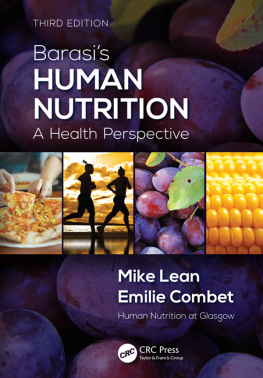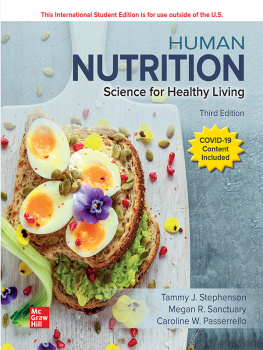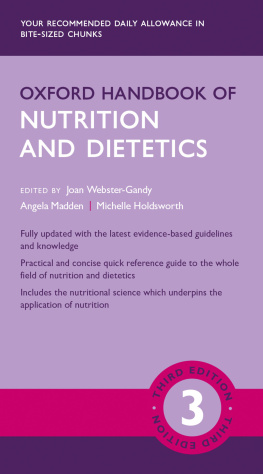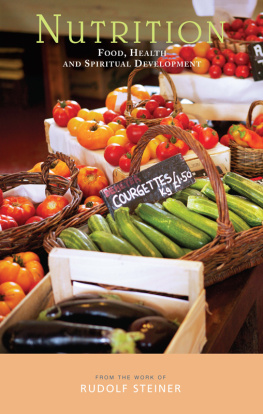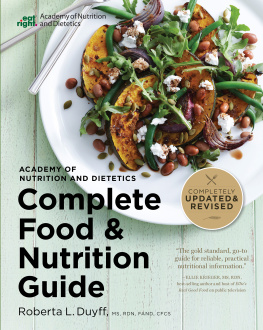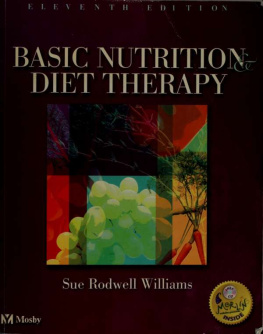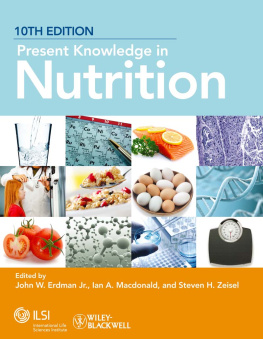Contents
Barasis
HUMAN
NUTRITION
A Health Perspective
THIRD EDITION
Barasis
HUMAN
NUTRITION
A Health Perspective
THIRD EDITION
Mike Lean
Emilie Combet
The University of Glasgow, UK

CRC Press
Taylor & Francis Group,
6000 Broken Sound Parkway NW, Suite 300,
Boca Raton, FL 33487-2742
2017 by Taylor & Francis Group, LLC
CRC Press is an imprint of Taylor & Francis Group, an Informa business
No claim to original U.S. Government works
Printed on acid-free paper
Version Date: 20160122
International Standard Book Number-13: 978-1-4441-3720-0 (Paperback)
This book contains information obtained from authentic and highly regarded sources. Reasonable efforts have been made to publish reliable data and information, but the author and publisher cannot assume responsibility for the validity of all materials or the consequences of their use. The authors and publishers have attempted to trace the copyright holders of all material reproduced in this publication and apologize to copyright holders if permission to publish in this form has not been obtained. If any copyright material has not been acknowledged please write and let us know so we may rectify in any future reprint.
Except as permitted under U.S. Copyright Law, no part of this book may be reprinted, reproduced, transmitted, or utilized in any form by any electronic, mechanical, or other means, now known or hereafter invented, including photocopying, microfilming, and recording, or in any information storage or retrieval system, without written permission from the publishers.
For permission to photocopy or use material electronically from this work, please access www.copyright.com (http://www.copyright.com/) or contact the Copyright Clearance Center, Inc. (CCC), 222 Rosewood Drive, Danvers, MA 01923, 978-750-8400. CCC is a not-for-profit organization that provides licenses and registration for a variety of users. For organizations that have been granted a photocopy license by the CCC, a separate system of payment has been arranged.
Trademark Notice: Product or corporate names may be trademarks or registered trademarks, and are used only for identification and explanation without intent to infringe.
Library of Congress Cataloging-in-Publication Data
Names: Lean, M. E. J. (Michael Ernest John), author. | Combet, Emilie,
author. | Barasi, Mary E. Human nutrition. Preceded by (work):
Title: Barasi's human nutrition : a health perspective / Michael E.J. Lean
and Emilie Co
Other titles: Human nutr
Description: Third edition. | Boca Raton : Taylor & Francis, 2017. | Preceded
by Human nutrition / Mary E. Barasi. 2nd ed. c2003. | Includes
bibliographical references and index.
Identifiers: LCCN 2016002285 | ISBN 9781444137200 (alk. paper)
Subjects: | MESH: Nutritional Requirements | Nutrition Processes | Diet |
Food | Food Habits | Nutrition Disorders
Classification: LCC QP141 | NLM QU 145.3 | DDC 613.2
LC record available at https://lccn.loc.gov/2016002285
Visit the Taylor & Francis Web site at
http://www.taylorandfrancis.com
and the CRC Press Web site at
http://www.crcpress.com
Contents
This third edition of Barasi's classic textbook has been a long time coming, after a period of great change. The reasons, translated into the needs behind this revised textbook, are multiple:
There is a major new emphasis on a joined-up translational approach across all bio-medical sciences, with a view to generate shifts in human behaviours to improve health. A great deal of perfectly good previous research failed in real life to have the impact suggested by clinical trials. Massive government and industry investments to develop new drugs looked diminished when consistent evidence emerged that many people do not want to take drugs. For example, around 30% of prescriptions for diabetes are not used, even when the drugs are provided for free by a national health service.
For human nutrition, we have a huge amount of solid information on the effects of nutrients, and nutrient balance, on physiology and disease risks. However, despite extensive health education and reports, population eating habits and nutrition-related diseases have changed very little. The three most frustrating research questions have always been (1) What do people (really) eat? (2) Why do people eat What they eat? and (3) What is needed to change the way they eat, sustainably?
A translational approach has pointed to the complexity of the food environment, a concatenation of environments and the policies behind them physical, agricultural, educational, social, but dominated by the commercial and marketing environment.
Population demographics have changed, to present greater emphasis on the needs of the elderly and young children in smaller families. Food provision for populations is clearly vital, but policies affecting national food provision have rarely included assessment of nutritional adequacy. They are mainly driven by the quest for commercial profit, thus, if possible, to buy cheap and sell expensive. This ethos has exaggerated the impact on the health of people at the extremes of age.
The wider recognition of the blindingly obvious that food and nutrition define human growth, development, mental and physical health, and thus susceptibility to most diseases has begun to register as a responsibility and accountability for carers and caterers, as well as for the medical and health professions.
In an era when healthcare is becoming hard to sustain, disease prevention enjoyed a renewed interest, with policy makers and health professionals beginning to accept that education does not solve the problem, since commercial food and drink marketing beats education every time. While Health by Stealth has been hailed as one of the only sustainable solutions, a better term is needed. We can anticipate, in the next decade, great investment into preventive measures based on covert reformulation of foods and meals, to ensure that all people are presented with foods and meals that provide nutrients in recommended proportions for optimal health. This applies particularly to the more vulnerable, at the extremes of age and through social and educational limitations. These are people whose health and well-being can only depend on decisions made by others on nutritional knowledge and guidance provided to their carers and caterers.
These changes come at a time when the media and the Internet are essentially unregulated, and the profusion of information or apparent information available or even thrust on people can be bewildering. Sifting truth, that is, secure, statistically sound evidence-based information, from plausible claims has become exceedingly difficult even for trained individuals.
Another change to the world of nutrition was the early loss of Mary Barasi in 2008. Mary was a renowned leader and teacher of nutrition and dietetics, holding posts in Scotland, Wales, England and Japan. She generated a buzz wherever she was, and her road to Damascus was probably stepping out to take an Open University degree in business administration. She saw the potential of the still very new Open University to spread education in what was still a very neglected field and designed a nutrition course for it, and that was the impetus behind her writing the first edition of this book.

